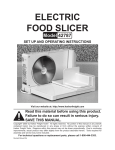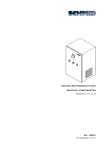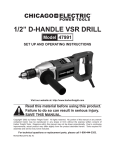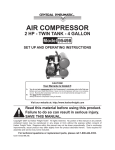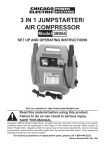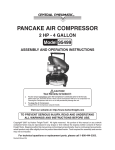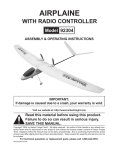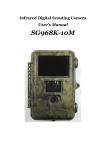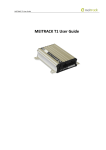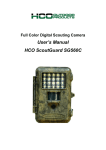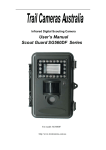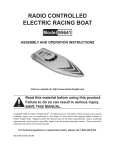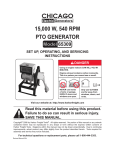Download Harbor Freight Tools 92906 User's Manual
Transcript
harbor cub Electric Remote Control Airplane Model 92906 assembly & Operating Instructions IMPORTANT: If damage is caused due to a crash, your warranty is void. Visit our website at: http://www.harborfreight.com Read this material before using this product. Failure to do so can result in serious injury. Save this manual. Copyright© 2005 by Harbor Freight Tools®. All rights reserved. No portion of this manual or any artwork contained herein may be reproduced in any shape or form without the express written consent of Harbor Freight Tools. Diagrams within this manual may not be drawn proportionally. Due to continuing improvements, actual product may differ slightly from the product described herein. Tools required for assembly and service may not be included. For technical questions or replacement parts, please call 1-800-444-3353. Revised Manual 09k THANK YOU for choosing a HARBOR FREIGHT TOOLS product. For future reference, please complete the owner’s record below: Model______________ Serial No._____________ Purchase Date_______________ SAVE THE RECEIPT, WARRANTY AND THESE INSTRUCTIONS. It is important that you read the entire manual to become familiar with the unit BEFORE you begin assembly. Technical Specifications Wingspan������������������������������ 371/2” Wing Area����������������������������� 212.3 sq. in. Fuselage Length������������������� 283/4” Flying Weight������������������������ 18.1 oz. Battery���������������������������������� 8.4V, 600 mAh, NiMh Flight Time���������������������������� About 10 minutes Remote Control��������������������� 3 Channel Remote Power���������������������� 8 “AA” Batteries (Not included) Safety Warnings and Precautions WARNING: When using product, basic safety precautions should always be followed to reduce the risk of personal injury and damage to equipment. Read all instructions before using this product! 1. Store idle equipment. When not in use, the Airplane must be stored in a dry location to inhibit damage from moisture and salt air. 2. Check for damaged parts. Before using the Airplane, any part that appears damaged should be carefully checked to determine that it will operate properly and perform its intended function. Check for any broken or damaged parts and any other conditions that may affect its operation. Replace or repair damaged or worn parts immediately. Do not use the Airplane if any part is damaged or broken. 3. Replacement parts and accessories. When servicing, use only identical replacement parts. Use of any other parts will void the warranty. 4. For ages 16 and over. Do not let children use the Airplane without adult supervision. Failure to do so could result in personal injury and/or property damage. 5. Keep your work area clean and well lit. Cluttered benches and dark areas invite accidents. 6. Always check hardware and assembled parts after assembling. All connections should be tight and hardware tightened. Rev 09j SKU 92906 For technical questions, please call 1-800-444-3353. Page 2 7. Dress properly. Wear restrictive hair covering to contain long hair. 8. Use eye protection. Always wear ANSI approved impact safety goggles when assembling and using this product. 9. Use the right Airplane and components. There are certain applications for which this Airplane was designed. Do not modify this Airplane and do not use this Airplane for a purpose for which it was not intended. 10. Do not use or assemble the Airplane if under the influence of alcohol or drugs. Read warning labels on prescriptions to determine if your judgement or reflexes are impaired while taking drugs. If there is any doubt, do not assemble or use the Airplane. 11. Do not pick up the Airplane while it is in motion. 12. Use only Batteries of the type recommended. 13. Do not mix old and new batteries. 14. Remove batteries if the Airplane is not used for a long period of time. 15. Make certain to use the Airplane in a large area free from interference from trees, electrical power lines and other obstacles. If two airplanes with the same frequency are used (both with the same numbers on the transmitter and/or receiver) they must be at least 1640 feet away from one another. 16. Never fly near buildings, cars or busy streets. 17. Do not fly the Airplane at or near other people or animals. 18. Keep this product away from small children; small parts can be easily swallowed. WARNING: The warnings, cautions, and instructions discussed in this instruction manual cannot cover all possible conditions and situations that may occur. It must be understood by the operator that common sense and caution are factors which cannot be built into this product, but must be supplied by the operator. Unpacking When unpacking your Airplane with Radio Controller, check to make sure the parts listed on the next page are included. If any parts are missing or broken, please call HARBOR FREIGHT TOOLS at 1-800-444-3353. Please read the following carefully THE MANUFACTURER AND/OR DISTRIBUTOR HAS PROVIDED THE PARTS DIAGRAM IN THIS MANUAL AS A REFERENCE TOOL ONLY. NEITHER THE MANUFACTURER NOR DISTRIBUTOR MAKES ANY REPRESENTATION OR WARRANTY OF ANY KIND TO THE BUYER THAT HE OR SHE IS QUALIFIED TO MAKE ANY REPAIRS TO THE PRODUCT OR THAT HE OR SHE IS QUALIFIED TO REPLACE ANY PARTS OF THE PRODUCT. IN FACT, THE MANUFACTURER AND/OR DISTRIBUTOR EXPRESSLY STATES THAT ALL REPAIRS AND PARTS REPLACEMENTS SHOULD BE UNDERTAKEN BY CERTIFIED AND LICENSED TECHNICIANS AND NOT BY THE BUYER. THE BUYER ASSUMES ALL RISK AND LIABILITY ARISING OUT OF HIS OR HER REPAIRS TO THE ORIGINAL PRODUCT OR REPLACEMENT PARTS THERETO, OR ARISING OUT OF HIS OR HER INSTALLATION OF REPLACEMENT PARTS THERETO. REV 05j SKU 92906 For technical questions, please call 1-800-444-3353. Page 3 Assembly/ Operation Your Airplane with Radio Controller will require complete assembly. It is important that you read the entire manual to become familiar with the product BEFORE you use the Airplane. Before assembling the Airplane be sure that you have all parts described in the Parts List and Assembly Diagram, below. Parts List Part Description Q’ty Part Description Q’ty Part Description Q’ty 1 Main Wing Assembly 1 8 Motor Cover 1 18 Wing Screw 6 1a Left Wing 1 9 Propeller 2* 19 Battery Cover 1 1b Right Wing 1 20 1” Screw 2 1c Top Wing Support 1 10 Landing Gear 1 21 Vertical Stabilizer 1 1d Bottom Wing Support 1 11 Remote Control 1 22 Tail Screw 3 2 Horizontal Stabilizer 1 12 Receiver 1 23 Strut Screw 2 3 Fuselage 1 13 Servo 2 24 Shaft Adapter 1 4 Pushrod 2 14 Battery Pack 1 25 Motor Cover Screw 2 5 Wing Strut 2 15 Charger 1 26 Landing Gear Brace 1 6 380 Motor 1 16 Speed Controller 1 27 Ribbon 1 7 Spinner Nut 1 17 Crystals (pair) 1 *Includes 1 spare Assembly Diagram NOTE:Some parts are listed and shown for illustration purposes only, and are not available individually as replacement parts. REV 08j SKU 92906 For technical questions, please call 1-800-444-3353. Page 4 Set out all parts on a clear and level surface prior to assembly. Wing Assembly 1. Position the Left and Right Wings (1a,1b) inside the Bottom Wing Support (1d) as shown in Figure 1. 2. Align the Top Wing Support (1c) in top of the Bottom Support and fasten the wing assembly together using the six Wing Screws (18). 3. The Wing Assembly (1) should balance on a flat surface with about 2” to 23/8” distance from the wing tips to the table. The height of both sides should be roughly equal. 4. Insert the two tabs at the back of the Bottom Wing Support (1d) into the holes on the top of the Fuselage (3). Gently press the front of the Wing Assembly (1) into place. Secure with the two 1” Screws (20). 5. Hook a Wing Strut (5) into the tabs underneath one Wing - see Figure 2. Make sure that the tab at the other end of the Strut (5) is angled properly to fit into the bottom of the Fuselage (3). Attach the strut to the bottom of the Fuselage (3) using a Strut Screw (23). Repeat for the other Strut and Wing. Figure 1 Left Wing (1a) Bottom Wing Support (1d) Figure 2 Wing Strut (5) Left/Right Wing (1a/1b) Right Wing (1b) Tail Assembly 1. 2. Use the remaining Tail Screw (22) to attach the Vertical Stabilizer (21) onto the tab on the end of the Fuselage (3) - see Figure 3. 3. Connect the clips on both Pushrods (4) to the tabs controlling the rudder and elevators. 4. Figure 3 Use two Tail Screws (22) to attach the Horizontal Stabilizer (2) onto the end of the Fuselage (3). With Servos energized adjust the clips on the pushrods, until both the elevators and rudder are straight and level. SKU 92906 Vertical Stabilizer (21) Tail Screw (22) For technical questions, please call 1-800-444-3353. REV 08j Page 5 Propeller Assembly Slide the Spinner Nut (7), Propeller (9), and Shaft Adapter (24) assembly onto the Motor’s (6) shaft at the nose of the plane. Tighten the internal hex screw on the side of the Adapter (24). Make sure that the Adapter (24) does not rub or interfere with any other part during operation. Landing Gear Assembly 1. Push Landing Gear (10) into the slot located under the front of the Fuselage (3). 2. Insert Landing Gear Brace (26) into the slot and press it firmly into place. IMPORTANT: If damage is caused due to a crash, your warranty is void. Battery Charging 1. Plug the Battery Pack (14) into the Charger (15) as shown in Figure 4, right. Plug the Charger (15) into a 120V electrical outlet. Allow up to three hours for the initial charge. Do not leave unattended when charging. Disconnect the Battery Pack (14) from the Charger (15) when the charge is complete. The batteries will become warm when they are ready for use. If you feel them becoming overly hot, immediately disconnect the Charger (15). Figure 4 Charger (15) Battery Pack (14) to Charger (15) connection Battery Pack (14) 2. Make certain that the “On/Off” Switch for the Airplane is in the “OFF” position. Turn the tabs at the edge of the Battery Cover (19) to the side and remove the Cover. Plug the Battery Pack (14) into the socket located underneath the Battery Cover (19). Insert the Battery Pack (14) into the Fuselage (3) and close the Battery Cover (19). Turn the tabs over the edge of the Cover to secure it. 3. Switch “OFF” the “ON/ OFF” Switch on the Remote Control (11). Remove cover and insert eight “AA” batteries (not included) into the Remote Control (11). REV 06e SKU 92906 For technical questions, please call 1-800-444-3353. Page 6 Remote Control (11) Figure 6 Figure 5 Ribbon (27) Battery indicator light Elevator control Rudder control Elevator trim Rudder trim Reverse toggles Back of Remote Control (11) Figure 7 Elevator Controls Plane Speed control “On/Off” trim adjustment control stick Setting up The Controls 1. Tie the Ribbon (27) to the end of the antenna, as shown in Figure 5. 2. Make certain that your hands are clear of the Propellers and any moving parts. Push the Plane Speed control all the way toward the L position - see Figure 6. Move both trim adjustments to the center. Turn on the switch on the Airplane and the switch on the Remote Control (11). 3. If the plane is adjusted properly, the rudder (on the Vertical Stabilizer (21) and elevators (on the Horizontal Stabilizer (2)) should be straight and level. 4. If either the Rudder or Elevators are not straight and level, the Clips at the end of the Pushrods (4) should be adjusted. This is done by turning the Clip IN (to shorten) or OUT (to lengthen) the Pushrod. Note: This should be done with Servos energized (power to Radio & Plane ON) for proper alignment. 5. Each control stick on the front of the control has a trim adjustment next to it, shown in Figure 5. These adjustments are used to fine-tune the position of the controls. They are typically used in flight to ensure that the plane can stay at a steady height and can fly straight more easily. 6. NOTE: The Plane Speed control is disabled until the Safety Button on the side of the Fuselage (3) is pressed. Leave it disabled until you are ready to fly the plane. Pushing the plane speed control (see Figure 6) upward, toward the H position, will cause the Propeller (9) to spin faster. Pushing the plane speed control back down, toward the L position, will slow down and stop the Propeller (9). 7. The rudder control stick controls the plane’s left and right direction. Move the control stick right to turn the rudder right, turning the plane right; and left to turn the rudder left, turning the plane left. When the control stick is in the center position, the rudder should also be centered. 8. The Elevator Control Stick changes the position of the Elevator which causes the Plane to climb or descend. Moving the Stick up causes the Elevator to more down making it possible for the Plane to descend; moving the Stick down causes the Elvator to move up making it possible for the Plane to climb. If the Stick is centered the Elevator should be level. 9. Practice these steps until you are comfortable with the controls. 10. The reverse toggles can be used to reverse the operation of the two front control sticks. Each reverse toggle controls the Control Stick nearest it. There are two settings: “N”=Normal Operation; “R”=Reversed Controls (left->right or forward->backward, and vice-versa). Flying the Airplane 1. Choose a day when the wind is light. The Ribbon (27) attached to the Remote Control antenna should be blowing slightly (not greater than 30 degrees) and not be blowing straight out. Find a wide-open field. REV 08j SKU 92906 For technical questions, please call 1-800-444-3353. Page 7 2. Switch the Remote Control (11) “ON” and the plane “ON”. Lastly, press the Safety Button on the side of the Fuselage (3) under the Right Figure 8 Wing (1b) - see Figure 8. 3. Face the Airplane into the wind. Move the Plane Speed Control all the way up so that the motor is running at full power. Note: If launching from a Rolling Take - off make sure Plane taxies straight, if not adjust Wheel Wires by bending one or both to achieve a controlled straight taxi. 4. Right Wing (1b) Safety Button ON/OFF Switch Fuselage (3) With Airplane at FULL POWER and taxiing in a straight line pull back on the Elevator Control to gain altitude and achieve Take - off. Note: If Hand Lauching it is recommended two people work together to launch the Plane, one to Launch and one to operate the Radio Transmitter. 5. If Hand Launching tilt the Plane up about 10°, propel in a straight line and release into the wind. 6. Let the Airplane climb to and fly at about 50 to 300 feet high. By moving the control sticks you can change pitch, direction, and speed. 7. If the Airplane rises too slowly, or dives, you may wish to adjust the elevator trim until the plane flies level with no pressure applied to the stick. 8. To steer the Airplane, move the rudder control stick to the left to steer to the left, and right to steer it right. Move the rudder control stick slightly to adjust for minor changes in direction and tilt of the Airplane. 9. If the airplane drifts to the right or left, you may adjust the rudder trim accordingly. If the Airplane continues to fly too far right or too far left, correct for it by moving the rudder control the opposite direction. If flying left, move the control right. If flying right, move the control left. If adjusting the rudder control does not work, land the Airplane and adjust the Rudder Pushrod (4) to compensate. 10. Note that letting go of the control sticks will automatically bring them to a center position. This will cause the Airplane to glide, unpowered. 11. Normal flight time for one full charge is about ten (10) minutes. If the plane appears to be losing power or climbs with difficulty, the batteries are low. Land the plane. 12. When the remote control’s battery begins to reach the end of its power, the red indicator light will blink or it will make a warning noise. When this occurs, IMMEDIATELY LAND THE AIRPLANE. If the remote control’s battery is allowed to die completely, the plane will be uncontrolled and may cause damage to property or SEVERE PERSONAL INJURY. 13. To bring in the Airplane for landing, glide the Airplane down against the wind. Move the plane speed control backwards to slow the Propeller (9). Pull the Elevator control stick back somewhat to pull the nose of the plane up. Move the rudder control stick to adjust for direction. Continue to gradually decrease the Propeller (9) speed until you bring it to a stop and land the Airplane. If airplane descends too quickly, press slightly harder on the plane speed control to compensate. REV 08j SKU 92906 For technical questions, please call 1-800-444-3353. Page 8








